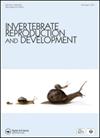西南大西洋瓷蟹Pachycheles laevidactylus Ortmann的种群生物学(异常目:瓷蟹科)
IF 0.8
4区 生物学
Q4 REPRODUCTIVE BIOLOGY
引用次数: 0
摘要
摘要采用性比、两性二态性、繁殖强度、相对生长和性成熟等指标对青瓷蟹种群进行了评价。瓷蟹的鉴定、性别和测量结果如下:甲壳(CL,长度);CW,宽度),螯合柄(PL,长度;PH,高度)和腹部(AL,长度;AW2和AW5分别为第2和第5腹肌宽度)。在分析的1109个标本中,性别比例为1:1,但在某些季节会形成对比。雌虫明显大于雄虫,四季均有雌虫卵生,秋冬两季密度较大。雄性大螯足(PHxCL和PLxCL)的生物特征比在体型上呈正异速,青春期后异速率下降。女性腹部的生物特征比(AW2xCL和AW5xCL)也出现了同样的情况。雄虫的形态性成熟期为3.48 mm,早于雌虫的5.00 mm。在本研究中,laevidactylus的成熟尺寸比报道的温带其他分析的大。这是第一个在亚热带气候的地区研究laevactylus种群生物学的方面。关键词:异速生长形态生殖性成熟披露声明作者未报告潜在的利益冲突。我们要感谢国家科学技术发展委员会- CNPq(研究奖学金资助MAAP: # 305957/2019-8)和本文章由计算机程序翻译,如有差异,请以英文原文为准。
Population biology of the porcelain crab Pachycheles laevidactylus Ortmann, 1892 (Anomura: porcellanidae) in the Southwestern Atlantic
ABSTRACTA population of the porcelain crab Pachycheles laevidactylus was evaluated based on sex ratio, sexual dimorphism, reproductive intensity, relative growth and sexual maturity. The porcelain crabs were identified, sexed and measured as follows: carapace (CL, length; CW, width), chelar propodus (PL, length; PH, height) and abdomen (AL, length; AW2 and AW5, the width of the 2nd and 5th abdominal somite, respectively). For the 1,109 specimens analyzed, the sex ratio was 1:1, but contrasted in some seasons. Females were significantly larger than males, and ovigerous females were recorded in all seasons, with greater intensity in autumn and winter. In males, the biometric ratios of the major chelar propodus (PHxCL and PLxCL) showed positive allometry regarding body size, with a reduction in the allometry rate after puberty. The same occurred with females for the biometric ratios of the abdomen (AW2xCL and AW5xCL). Males attain morphological sexual maturity at 3.48 mm CL, earlier than females, which occurred at 5.00 mm CL. In this study, P. laevidactylus matured with a larger size than reported for others analyzed in the temperate zone. It is the first study addressing aspects of the population biology of P. laevidactylus in a region with a subtropical climate.KEYWORDS: Allometrygrowthmorphologyreproductionsexual maturity Disclosure statementNo potential conflict of interest was reported by the author(s).Additional informationFundingWe want to thank the National Council for Scientific and Technological Development - CNPq (Research Fellowship Grant to MAAP: # 305957/2019-8) and the São Paulo Research Foundation - FAPESP for the financial support provided to MAAP (# 1998/6055-0, # 2022/05614-2, # 2009/14725-1 and # 2014/50438-5) and the Master Fellowship Grant MCAJ (# 2019/16581-9).
求助全文
通过发布文献求助,成功后即可免费获取论文全文。
去求助
来源期刊
CiteScore
1.90
自引率
0.00%
发文量
21
审稿时长
>12 weeks
期刊介绍:
Invertebrate Reproduction & Development ( IRD) presents original research on the reproductive and developmental biology of the Invertebrata, both embryonic and postembryonic. IRD welcomes papers reporting significant results obtained using new techniques. Encouraged topic areas include: aquaculture, physiology, biochemistry, functional morphology, phylogeny, behavioural and regulatory mechanisms, including genetic, endocrine and molecular studies. Papers containing qualitative descriptions of reproductive cycles and gametogenesis will not be considered. IRD is published in association with the International Society of Invertebrate Reproduction and Development.

 求助内容:
求助内容: 应助结果提醒方式:
应助结果提醒方式:


